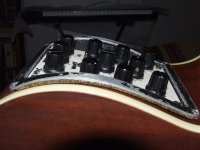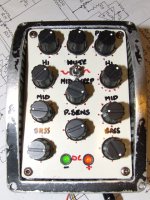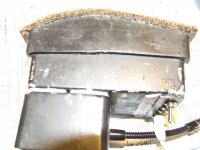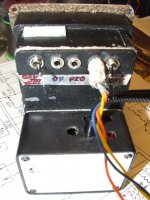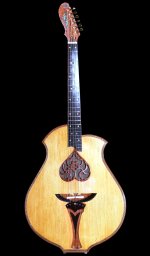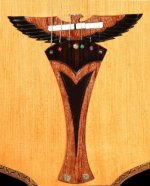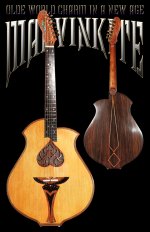I'm fairly intermediate with electronics, but feel confident to be able to build circuits from a schematic.
I want to build an onboard preamp for my acoustic guitar, whose electronics have died. The electronics on it have a piezzo pickup and microphone that are mixed together. There is a three band eq and a phase switch.
I would like to build a similar circuit. I'd like a preamp with eq, a mixer to mix the two sources (piezzo and mic), and a balanced output that can be powered from a battery or phantom power. (Similar to the HT-MC here: ARTEC) I also want a 1/4" hi-z output and a 1/4" channel insert for an effects side-chain. I don't need the phase switch.
I have found several schematics that would be suitable, but in my research, it seems that phantom power has limited current available, so I am confused as to how to continue. I don't know if the circuits I've seen will draw too much power, or what. Therefore, I would like assistance from the group as to a circuit that may be suitable for my application. I mainly need help with the preamp part. Should it be discrete so as to draw less power, or are there opamps that are low power enough to do the job?
Also, I'm confused as to how to get the power out of the xlr (phantom power) and use it to power the circuit.
Thanks for any assistance you can give.
John
I want to build an onboard preamp for my acoustic guitar, whose electronics have died. The electronics on it have a piezzo pickup and microphone that are mixed together. There is a three band eq and a phase switch.
I would like to build a similar circuit. I'd like a preamp with eq, a mixer to mix the two sources (piezzo and mic), and a balanced output that can be powered from a battery or phantom power. (Similar to the HT-MC here: ARTEC) I also want a 1/4" hi-z output and a 1/4" channel insert for an effects side-chain. I don't need the phase switch.
I have found several schematics that would be suitable, but in my research, it seems that phantom power has limited current available, so I am confused as to how to continue. I don't know if the circuits I've seen will draw too much power, or what. Therefore, I would like assistance from the group as to a circuit that may be suitable for my application. I mainly need help with the preamp part. Should it be discrete so as to draw less power, or are there opamps that are low power enough to do the job?
Also, I'm confused as to how to get the power out of the xlr (phantom power) and use it to power the circuit.
Thanks for any assistance you can give.
John
Here's a link to a circuit similar to the DI I want to use, I just need to add a preamp with 3 or 4 band EQ to it.
ESP - Direct Injection Box for Recording and PA Systems
Anybody?
ESP - Direct Injection Box for Recording and PA Systems
Anybody?
So, I think I've decided on an AD820 as the opamps I will use in my circuit. If I understand the data sheet correctly, I can use it with single supply power and not need to create a virtual ground. If someone could check my thoughts on this, that would be great.
Here's the link: http://www.analog.com/static/imported-files/data_sheets/AD820.pdf
I'm working on a schematic, so I'll post when I'm done with it.
John
Here's the link: http://www.analog.com/static/imported-files/data_sheets/AD820.pdf
I'm working on a schematic, so I'll post when I'm done with it.
John
For single supply operation, the op amp can be biased with two 2.2M resistors to a voltage 1/2 of V+.
http://www.jer00n.nl/2010/07/28/clean-boost-for-guitar-or-bass/

http://www.jer00n.nl/2010/07/28/clean-boost-for-guitar-or-bass/

Last edited:
Hey, thanks. I know this, already. I wanted to know if this particular opamp would work without the biasing from 1/2V+.
The data sheet says "The AD820 is a precision, low power FET input op amp that can operate from a single supply of 5 V to 36 V, or dual supplies of ±2.5 V to ±18 V. It has true single-supply capability, with an input voltage range extending below the negative rail, allowing the AD820 to accommodate input signals below ground in the single-supply mode."
Does that mean it will work without the biasing from 1/2 V+. Also, is the biasing the same as a virtual ground (floating gound), or am I confused?
John
The data sheet says "The AD820 is a precision, low power FET input op amp that can operate from a single supply of 5 V to 36 V, or dual supplies of ±2.5 V to ±18 V. It has true single-supply capability, with an input voltage range extending below the negative rail, allowing the AD820 to accommodate input signals below ground in the single-supply mode."
Does that mean it will work without the biasing from 1/2 V+. Also, is the biasing the same as a virtual ground (floating gound), or am I confused?
John
The DC gain of the op amp is one, with the + input at 4.5 V the output will be at 4.5 V. This allows the output to swing equally in both directions before clipping. The AD820 output can swing very close to the supply limits, others may not do as well. Keep in mind the input will see the bias voltage and signal +/- peak voltage. The op amp will work well when biased at 4.5 V, but will work within the Common Mode Range. See note 1 in the data sheet.
I recently installed a coax Piezo UTS pickup in my acoustic. I build a charge-amp buffer that works fine plugged into HI-Z or line level. Tried a few different buffer ideas and that had the best, most realistic acoustic sound that could be had from a piezo. Any filtering would only color the sound, though I sized the input cap and resistors to be -3db down at 40hz to remove some of the string/pump noise. The charge amp is not good for a electret pickup though. A different buffer/voltage amp is needed there.
Here is a good, simple charge amp and basically what I followed....
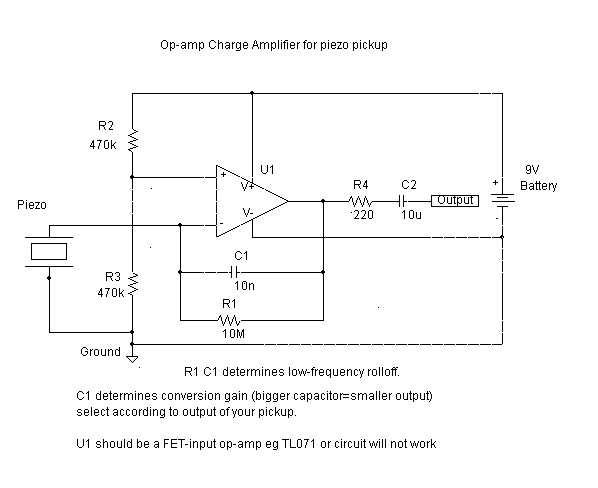
I see no need to worry about limiting yourself to "single supply" and not biasing to V+/2.
Think about your phantom source supply capability. You will likely be using a few opamps for this so check their current draw and ensure the phantom can handle it all of it. Large/pro supplies will not have issue but if you have a small hobby-level phantom supply might be under powered.
A 3 band baxandall tone might be nice. Lots of designs around the web, here is one to get you startedhttp://www.simplecircuitdiagram.com/wp-content/uploads/2010/05/3-Band-Equalizer.gif
I'd suggest have separate buffers for each mic type, followed by summing with blend using an opamp, then to a tone control similar to the last link, followed by the balanced output buffer.
I'd question the need for the balanced out however, and would save you work and battery/current. If you skip the balanced output, you could do this with one quad opamp, or 2 duals.
Here is a good, simple charge amp and basically what I followed....

I see no need to worry about limiting yourself to "single supply" and not biasing to V+/2.
Think about your phantom source supply capability. You will likely be using a few opamps for this so check their current draw and ensure the phantom can handle it all of it. Large/pro supplies will not have issue but if you have a small hobby-level phantom supply might be under powered.
A 3 band baxandall tone might be nice. Lots of designs around the web, here is one to get you startedhttp://www.simplecircuitdiagram.com/wp-content/uploads/2010/05/3-Band-Equalizer.gif
I'd suggest have separate buffers for each mic type, followed by summing with blend using an opamp, then to a tone control similar to the last link, followed by the balanced output buffer.
I'd question the need for the balanced out however, and would save you work and battery/current. If you skip the balanced output, you could do this with one quad opamp, or 2 duals.
Ok, I've got most of my circuit planned. The top part of the schematic came, mostly, from G. Randy Slone's book "The Audiophile's Project Sourcebook". I chose those circuits for their simplicity and few opamps, thereby, reducing power consumption.
The bottom part is from the circuit at the bottom of the link in my second post (ESP - Direct Injection Box for Recording and PA Systems), but with the same AD822's that I talked about earlier. The only part I don't have done yet is the "panning" from the mic to the piezo. Any help there would be appreciated!
Now, designing/theory are not concepts that I have a good knowledge in yet, so I can't tell you if I'm overloading some part of a circuit or what. I'm just going off what I found in bits and pieces. Therefore, please feel free to tell me if I'm doing something wrong here. Also, I am unable to simulate the circuit because it keeps telling me that gmin step failed, etc.
I've attached a pic of the file (sorry if the stuff is crowded or hard to read, it's a drawback of the program I use).
The bottom part is from the circuit at the bottom of the link in my second post (ESP - Direct Injection Box for Recording and PA Systems), but with the same AD822's that I talked about earlier. The only part I don't have done yet is the "panning" from the mic to the piezo. Any help there would be appreciated!
Now, designing/theory are not concepts that I have a good knowledge in yet, so I can't tell you if I'm overloading some part of a circuit or what. I'm just going off what I found in bits and pieces. Therefore, please feel free to tell me if I'm doing something wrong here. Also, I am unable to simulate the circuit because it keeps telling me that gmin step failed, etc.
I've attached a pic of the file (sorry if the stuff is crowded or hard to read, it's a drawback of the program I use).
Attachments
Hi,
I went completely the other way! I wanted to design a pre which would have (almost) all the bells & whistles found on a half/full 1U unit, yet would be able to be fitted on the side of an acoustic guitar.
Thinking on similar lines as you have done, I basically designed 2 seperate preamps for;
1. An electret mic -Panasonic WM61A 3wire Linkwitz modified with bass/treble + parametric mid
2. A Piezo Disc with Baxandhall 3 way tone control
3. An Inverter Switch with Simple mechanical Mute
4. A Summing Mixer with both unbalanced/balanced & Passive 3dB balanced output.
"Phantom" power was discarded at a very early stage since I decided to use commonly found DIP IC's like TL072,NE5532,LM6542 etc.I used 2x 1200mA smoke detector PP3 battaries in the begining,but soon realized that these too wouldn't last long,due to the fairly high current demands of some of the ICs I had chosen.
So I opted for a full +/- 15V DC & built my own PSU for it. This required an additional DC power cable from the PSU to the onboard pre. This is only a minor inconvenience as far as I am concerned.
The biggest problem I encounted however was a finding a suitable, light weight casing for the unit! I couldn't find a single unit depite fine combing almost all the manufacturers sites & catalogues!,so ended up modifying an aluminum case only to find out that it was heavy enough to dampen the volume & timbre of the guitar! So, now I'm in the process of making a similar casing in ABS plastic!
I went completely the other way! I wanted to design a pre which would have (almost) all the bells & whistles found on a half/full 1U unit, yet would be able to be fitted on the side of an acoustic guitar.
Thinking on similar lines as you have done, I basically designed 2 seperate preamps for;
1. An electret mic -Panasonic WM61A 3wire Linkwitz modified with bass/treble + parametric mid
2. A Piezo Disc with Baxandhall 3 way tone control
3. An Inverter Switch with Simple mechanical Mute
4. A Summing Mixer with both unbalanced/balanced & Passive 3dB balanced output.
"Phantom" power was discarded at a very early stage since I decided to use commonly found DIP IC's like TL072,NE5532,LM6542 etc.I used 2x 1200mA smoke detector PP3 battaries in the begining,but soon realized that these too wouldn't last long,due to the fairly high current demands of some of the ICs I had chosen.
So I opted for a full +/- 15V DC & built my own PSU for it. This required an additional DC power cable from the PSU to the onboard pre. This is only a minor inconvenience as far as I am concerned.
The biggest problem I encounted however was a finding a suitable, light weight casing for the unit! I couldn't find a single unit depite fine combing almost all the manufacturers sites & catalogues!,so ended up modifying an aluminum case only to find out that it was heavy enough to dampen the volume & timbre of the guitar! So, now I'm in the process of making a similar casing in ABS plastic!
Attachments
Last edited:
I know it's an old thread, but I see you DID update it in July '012. Why did you abandon the notion of using 48v phantom power? Wouldn't ohm's law prevail and give you suitable current at, say plus minus 18V? It seems to me starting out with 48volts/amps/current is much better than splitting 9volts or even lipo 12volts? Also, did you succeed in getting a suitable case, and would you be willing to post your schematics? I'm fitting a boundary mic in my latest prototype acoustic that I just finished. I was thinking of just using phantom power for everything. Here's a photo showing the condenser mic built into the hand-carved bridge.
Attachments
Firststly, congratulations on your nice unusual guitar! Unusual shape too! This may go very well in the AGP Forum!
I opted for BJT & JFET ics known to me at that time & the circuit consumes fairly high current around 50mA. So this ruled out single 9v battery.Then I tried 2 x 9v in +/- as a virtual psu, but this didn't sound as good as it did on +/-12v DC. The mic is then biased directly from the circuit board & since the mic was fitted on the guitar & very close to the onboard preamp, I found phantom powering & balanced output unneccessary.
If you're planning using p.power, then remember that the maximum current it can ouput & carry through a balanced guitar cable would be only 5mA! But this shouldn't be a problem if you're going to fit the battery inside the guitar. Why then use p.power? If your circuit requires only 5mA max on a single supply then p.power is viable if you're planning on external psu/phantom powering.
I know that there are opamps which can work on +/-18v...but then you'd be driving these very hard & hot,reducing their life cycle IMHO. This shouldn't be a problem for just +18v.
One thing discovered was that fitting my heavy preamp/case @350g actually reduced the timbre & loudness of the guitar considerably,at least when played acoustically! However, this didn't have much detrimental effect when elctrified. I've now made an ABS case,actually modified, & glued together from various stock cases...which is much lighter & doesn't affect the guitar sound as much as it did with the aluminum case. There were no EMI or RF issues either what so ever.
As for the circuits The charge circuit is exactly the same as the one shown earlier here by someone with just the 2 bias resistors removed for dual supply. The mic circuit is the much loved ,modded & discussed "Linkwitz" 3 wire modified. Summing/mixer/output is just a 2 input virtual earth opamp with low noise BJT like NE5532,LM4562 or similar for this. JFETs will not work well with long cables & tend to oscillate. These also have fairly high o/p impedance. JFETS are no good for output stages,I'm sure you know this already!
I opted for BJT & JFET ics known to me at that time & the circuit consumes fairly high current around 50mA. So this ruled out single 9v battery.Then I tried 2 x 9v in +/- as a virtual psu, but this didn't sound as good as it did on +/-12v DC. The mic is then biased directly from the circuit board & since the mic was fitted on the guitar & very close to the onboard preamp, I found phantom powering & balanced output unneccessary.
If you're planning using p.power, then remember that the maximum current it can ouput & carry through a balanced guitar cable would be only 5mA! But this shouldn't be a problem if you're going to fit the battery inside the guitar. Why then use p.power? If your circuit requires only 5mA max on a single supply then p.power is viable if you're planning on external psu/phantom powering.
I know that there are opamps which can work on +/-18v...but then you'd be driving these very hard & hot,reducing their life cycle IMHO. This shouldn't be a problem for just +18v.
One thing discovered was that fitting my heavy preamp/case @350g actually reduced the timbre & loudness of the guitar considerably,at least when played acoustically! However, this didn't have much detrimental effect when elctrified. I've now made an ABS case,actually modified, & glued together from various stock cases...which is much lighter & doesn't affect the guitar sound as much as it did with the aluminum case. There were no EMI or RF issues either what so ever.
As for the circuits The charge circuit is exactly the same as the one shown earlier here by someone with just the 2 bias resistors removed for dual supply. The mic circuit is the much loved ,modded & discussed "Linkwitz" 3 wire modified. Summing/mixer/output is just a 2 input virtual earth opamp with low noise BJT like NE5532,LM4562 or similar for this. JFETs will not work well with long cables & tend to oscillate. These also have fairly high o/p impedance. JFETS are no good for output stages,I'm sure you know this already!
Last edited:
WOW! Thanks teleman for answering! 'Teleman' (i'm guessing because you either play a telecaster, or worked for Ma Bell as an audio engineer...or something). Thanks for the updates. I can't believe that only 5ma survives the cable run for a standard length XLR mic cable. If that 5ma potential is for 48volts, wouldn't that increase when the voltage is lowered (ohm's law)? Believe me, I'm no electrical engineer, that's why I depend on the input from some of you guys on this board. I think it is still an elegant solution for this particular design. I just want to use the electret (linkwitz modded of course) with no option for e.q., undersaddle piezo, or even a volume control. I've mixed sound on many different boards, and they all (even the cheap ones) have much better noise specs and sound shaping (parametric e.q., effect sends, etc.) than ANY onboard preamp. Especially since most onboard pre's are only 9volt. If you think I'm crazy for trying, please let me know, and keep in touch. I don't know if you even play acoustic as your main instrument, but you can see that I'm not running with the pack. I'm a firm believer in DIY, and stepping outside the box. If you can help me out, I would much appreciate it. I have looked into the LM4562, and decided on a balanced line driver instead - the LME49724. Check it out. I'm looking into a 'shoeps' style balanced front-end with the (phantom powered, mind you) 49724 outputting to a mixer console. My acoustic clientele would probably have an audio guy running sound for them, anyway.
Thanks Marvinkite,
Good guess/assumption.Yes, I do own & play a Tele..albeit only a 1977 Ibanez clone. I Had a Washman Falcon briefly,but sold it quickly. It was no surprise that my user name was a giveaway. Lol. As for being a tech at Ma Bel...never been near that place! don't know even where the h--- it is. I'm actually in a different part of the globe! I wish I had done my share behind desk,as it was & still in front of it, on stage, mostly I guess!
I now play ony acoustic & enjoy every minute of it! Enough said.
Ok, here is my take on mikes & preamps..so take it with a pinch of salt will ya?
Most condenser onboard pre amps are designed to accept 48-52v phantom power (dc) @4-5 mA directly through balanced mic outs from mixers. In addition, onboard pres are also generally powered by a 9v PP3 battery, providing an unbalanced output. As a rule ph.psu is designed to deliver only this small current & is stipulated as the industry standard protocol. So,to facilitate this, very low current ics are employed in the pre-amp designs. However, it won't be any problem if you only want to feed the mic with 48v @4mA! To quote you,"If that 5ma potential is for 48volts, wouldn't that increase when the voltage is lowered (ohm's law)? " yes, but then please remember that guitar cables can carry only very small ac signals of few mA & the cable may well melt it's sheathing/insulation & short circuit the whole thing in the process!. Another alternative would be is to use 12v supply aka "T" powering. Then again this too delivers only up to 12v @ fairly low currents. You can certainly power any condenser mic by p.power,but one has to aware of current constraints of driving high current pre-amps through signal cables.
As for using the mic pre amp without any eq or gain control, will not work IMHO as you're assuming.Let me explain. A high gain,un eqed mike/ pre with a gain of 20dB or so will behave quite differently when performing measuring tasks in free air to being inside an enclosed chamber,i.e.the guitar body! Since the mic may likely to have dips & bumps in it's freq.response, it will definitely howl & feedback without any proper gain control,eq or feedback limiting circuit! Mics are difficult beasts to tame, especially in confined, enclosed spaces. So driving high level unfiltered signals directly to a mixer board is certainly not a good idea! Ideally,you'd need a low gain input stage, some 6-12db eq control in the least to make it viable. Besides, Just imagine having to depend entirely on the sound engineer every time you get uncontrollable feedback or need to make simple adjustments such as volume & so on? Bad idea i.m.h.o!
Good on you mate that you too are thinking out of the box.Believe me, I too spent the best part of last 4 years experimenting & doing things out of the box with some mixed results. However,in my case, it was mainly due to my lack of solid technical knowledge, which allowed me to imagine solutions beyond any theoretical reasoning or possibilities! Yes, I did solve a few unusual problems in my ignorant bliss...yet could have saved my self a lot time & frustration, if only had I looked up & read these subjects beforehand! I probably would have wasted even more valuable time if it wasn't for some good help & advice from a few kind fellow members in this & a few other forums.
Do experiment by all means,but also use & take on board tried & tested methods & advice from our peers as well. Read as much as you can on every stage of the subject! Sorry if I sounded patronizing!....never meant to be though!
Keep on....
Good guess/assumption.Yes, I do own & play a Tele..albeit only a 1977 Ibanez clone. I Had a Washman Falcon briefly,but sold it quickly. It was no surprise that my user name was a giveaway. Lol. As for being a tech at Ma Bel...never been near that place! don't know even where the h--- it is. I'm actually in a different part of the globe! I wish I had done my share behind desk,as it was & still in front of it, on stage, mostly I guess!
I now play ony acoustic & enjoy every minute of it! Enough said.
Ok, here is my take on mikes & preamps..so take it with a pinch of salt will ya?
Most condenser onboard pre amps are designed to accept 48-52v phantom power (dc) @4-5 mA directly through balanced mic outs from mixers. In addition, onboard pres are also generally powered by a 9v PP3 battery, providing an unbalanced output. As a rule ph.psu is designed to deliver only this small current & is stipulated as the industry standard protocol. So,to facilitate this, very low current ics are employed in the pre-amp designs. However, it won't be any problem if you only want to feed the mic with 48v @4mA! To quote you,"If that 5ma potential is for 48volts, wouldn't that increase when the voltage is lowered (ohm's law)? " yes, but then please remember that guitar cables can carry only very small ac signals of few mA & the cable may well melt it's sheathing/insulation & short circuit the whole thing in the process!. Another alternative would be is to use 12v supply aka "T" powering. Then again this too delivers only up to 12v @ fairly low currents. You can certainly power any condenser mic by p.power,but one has to aware of current constraints of driving high current pre-amps through signal cables.
As for using the mic pre amp without any eq or gain control, will not work IMHO as you're assuming.Let me explain. A high gain,un eqed mike/ pre with a gain of 20dB or so will behave quite differently when performing measuring tasks in free air to being inside an enclosed chamber,i.e.the guitar body! Since the mic may likely to have dips & bumps in it's freq.response, it will definitely howl & feedback without any proper gain control,eq or feedback limiting circuit! Mics are difficult beasts to tame, especially in confined, enclosed spaces. So driving high level unfiltered signals directly to a mixer board is certainly not a good idea! Ideally,you'd need a low gain input stage, some 6-12db eq control in the least to make it viable. Besides, Just imagine having to depend entirely on the sound engineer every time you get uncontrollable feedback or need to make simple adjustments such as volume & so on? Bad idea i.m.h.o!
Good on you mate that you too are thinking out of the box.Believe me, I too spent the best part of last 4 years experimenting & doing things out of the box with some mixed results. However,in my case, it was mainly due to my lack of solid technical knowledge, which allowed me to imagine solutions beyond any theoretical reasoning or possibilities! Yes, I did solve a few unusual problems in my ignorant bliss...yet could have saved my self a lot time & frustration, if only had I looked up & read these subjects beforehand! I probably would have wasted even more valuable time if it wasn't for some good help & advice from a few kind fellow members in this & a few other forums.
Do experiment by all means,but also use & take on board tried & tested methods & advice from our peers as well. Read as much as you can on every stage of the subject! Sorry if I sounded patronizing!....never meant to be though!
Keep on....
Last edited:
Marvinkite, this is in response to your earlier question you posted.
"Why did you abandon the notion of using 48v phantom power? Wouldn't ohm's law prevail and give you suitable current at, say plus minus 18V? It seems to me starting out with 48volts/amps/current is much better than splitting 9volts or even lipo 12volts?"
I think you've misunderstood phantom power supply am afraid! Phantom power is just +48v single rail dc supply with a max. current capacity of just 4-5mA. This voltage is first tapped from either the main or a dedicated psu of a mixer,mic preamp or a dedicated phantom psu unit!
This is voltage is then split by 2 matched 6.81 resistors & fed to +2 pin (non inverting) & -3 pin (inverting) of all or a selected few XLR mic inputs of a mixer or mic pre-amp! Hence this is also known as active balanced mic input or passive when ph.power is switched off.
Phantom supply is primarily to power condenser mics which require 48v supply voltage, but can also supply most condenser mics requiring 9- 48v,since low voltage mics have their own internal attenuator circuits to accept the required lower supply.
If an onboard pre amp is designed with low current ics to consume only 4-5mA in total,then p.power supply can be supplied to the unit through an XLR & the pre-amp output is taken through the same XLR +2/-3pins at the same time!
"Why did you abandon the notion of using 48v phantom power? Wouldn't ohm's law prevail and give you suitable current at, say plus minus 18V? It seems to me starting out with 48volts/amps/current is much better than splitting 9volts or even lipo 12volts?"
I think you've misunderstood phantom power supply am afraid! Phantom power is just +48v single rail dc supply with a max. current capacity of just 4-5mA. This voltage is first tapped from either the main or a dedicated psu of a mixer,mic preamp or a dedicated phantom psu unit!
This is voltage is then split by 2 matched 6.81 resistors & fed to +2 pin (non inverting) & -3 pin (inverting) of all or a selected few XLR mic inputs of a mixer or mic pre-amp! Hence this is also known as active balanced mic input or passive when ph.power is switched off.
Phantom supply is primarily to power condenser mics which require 48v supply voltage, but can also supply most condenser mics requiring 9- 48v,since low voltage mics have their own internal attenuator circuits to accept the required lower supply.
If an onboard pre amp is designed with low current ics to consume only 4-5mA in total,then p.power supply can be supplied to the unit through an XLR & the pre-amp output is taken through the same XLR +2/-3pins at the same time!
Last edited:
I'M SUCH AN IDIOT
First, I didn't even connect the dots with the British Union Jack right there! Uhgggg! Sorry Mate! Ma Bell relates to the famous Bell telephone corporation here in the U.S. that fell out of grace with government anti-monopoly regulators and had to be broken up into several spin-off companies. 'tele'-is short for telephone, and Bell Labs is a proper breeding ground for many audio engineers, which I thought you might be one of. I'm glad, however, to know you are a musician after all. I DID check out T power that utilizes lower resistance levels on balanced audio rails to allow up to 12vdc instead of pinching off the phantom 48 volts with 6.8k resistors. I can also bias the dc potential for the electret's FET source voltage with a 10volt zener, or series resistance drop (with a little more noise) and still drive an op amp with phantom. I agree that having some control over the dynamics of the mic would be wise, but this mic is NOT inside an enclosure. It is a boundary mic that utilizes the half-space of the guitar top as the pickup area. The guitar has an anti-feedback grille to help break the sound waves coming out ot the body, helping prevent feedback. Even the most sophisticated onboard mic pre's don't have limiters or threshold adjustments for gain stages, which modern mixers with effects all have. In short, I'm not thoroughly convinced that onboard pre's are better. I AM convinced, however, that microphones are the best transducer for acoustic guitars over undersaddle and under top (even dual placement) piezo elements or magnetic sound-hole type pickups. These produce unnatural sounds. Sometimes, less is more-if done correctly, which is what I'm after.
First, I didn't even connect the dots with the British Union Jack right there! Uhgggg! Sorry Mate! Ma Bell relates to the famous Bell telephone corporation here in the U.S. that fell out of grace with government anti-monopoly regulators and had to be broken up into several spin-off companies. 'tele'-is short for telephone, and Bell Labs is a proper breeding ground for many audio engineers, which I thought you might be one of. I'm glad, however, to know you are a musician after all. I DID check out T power that utilizes lower resistance levels on balanced audio rails to allow up to 12vdc instead of pinching off the phantom 48 volts with 6.8k resistors. I can also bias the dc potential for the electret's FET source voltage with a 10volt zener, or series resistance drop (with a little more noise) and still drive an op amp with phantom. I agree that having some control over the dynamics of the mic would be wise, but this mic is NOT inside an enclosure. It is a boundary mic that utilizes the half-space of the guitar top as the pickup area. The guitar has an anti-feedback grille to help break the sound waves coming out ot the body, helping prevent feedback. Even the most sophisticated onboard mic pre's don't have limiters or threshold adjustments for gain stages, which modern mixers with effects all have. In short, I'm not thoroughly convinced that onboard pre's are better. I AM convinced, however, that microphones are the best transducer for acoustic guitars over undersaddle and under top (even dual placement) piezo elements or magnetic sound-hole type pickups. These produce unnatural sounds. Sometimes, less is more-if done correctly, which is what I'm after.
Union Jack! I must be in the wrong country again! Lol!! It's norwegian actually!
Ok.So you want to power this boundary mic, right? Does it run on 9,12 or 48v dc? The whole idea of feeding 48v p.power is also to have balanced in/out buffer to the mic with low impedance, better noise & increased o/p level. Add a 100k? resistor in series for 12 volts. "T" powered (24v) circuit is a little cumbersome & uses only resistors
I think zeners are noisier than resistors. I totally agree with you on your reluctance to use UST,MPUs etc. I've been there & tried all that. However, you'd need to power the mic & the FET, hence require some sort of power source & a nice low noise balanced mic buffer circuit. All this can be built quite easily on a 1 sq.inch perfo board & fitted inside the guitar or on the mic itself!
Ok.So you want to power this boundary mic, right? Does it run on 9,12 or 48v dc? The whole idea of feeding 48v p.power is also to have balanced in/out buffer to the mic with low impedance, better noise & increased o/p level. Add a 100k? resistor in series for 12 volts. "T" powered (24v) circuit is a little cumbersome & uses only resistors
I think zeners are noisier than resistors. I totally agree with you on your reluctance to use UST,MPUs etc. I've been there & tried all that. However, you'd need to power the mic & the FET, hence require some sort of power source & a nice low noise balanced mic buffer circuit. All this can be built quite easily on a 1 sq.inch perfo board & fitted inside the guitar or on the mic itself!
Last edited:
OMG IDIDITAGAIN!!!
Sorreeee! I guess I'm that arrogant American who doesn't know his european flags. Soooo sorry. Norway is AWESOME! I have actually studied about the fjords and certain aspects of your Country (like it bordering old communist Russia). Way cool! Ummm, I guess I can send you a schematic that I have been working on, but I also want you to check out the LME 49724 balanced line driver. I would like your opinion if you think phantom power can drive it. Let's stay in touch, and I'll send you the two versions I have been breadboarding. Let me know if you want to see other pictures of my acoustic prototype, yeah?
Sorreeee! I guess I'm that arrogant American who doesn't know his european flags. Soooo sorry. Norway is AWESOME! I have actually studied about the fjords and certain aspects of your Country (like it bordering old communist Russia). Way cool! Ummm, I guess I can send you a schematic that I have been working on, but I also want you to check out the LME 49724 balanced line driver. I would like your opinion if you think phantom power can drive it. Let's stay in touch, and I'll send you the two versions I have been breadboarding. Let me know if you want to see other pictures of my acoustic prototype, yeah?
Phantom powered preamp
Hi Teleman,
it is no problem to find a low power op amp for your needs. There are some low power op amps on the market. I use the LT1014 in my Smart DI ( The Smart DI ) and still had some power left to feed a microcontroller and an lcd display. However pls. note that it´s always a balance act between low noise and power consumption. The low power op amps usually have a bit higher noise floor compared to the "high power" op amps. For my opinion the LT1014 is a good compromise between that and with the noise floor almost similar to a 084. The rest is just a bit power saving design. So, in your case you still can use a microcontroller and an lcd display for a build in tuner...
Have fun!
All the best!
Axel
Hi Teleman,
it is no problem to find a low power op amp for your needs. There are some low power op amps on the market. I use the LT1014 in my Smart DI ( The Smart DI ) and still had some power left to feed a microcontroller and an lcd display. However pls. note that it´s always a balance act between low noise and power consumption. The low power op amps usually have a bit higher noise floor compared to the "high power" op amps. For my opinion the LT1014 is a good compromise between that and with the noise floor almost similar to a 084. The rest is just a bit power saving design. So, in your case you still can use a microcontroller and an lcd display for a build in tuner...
Have fun!
All the best!
Axel
WELCOME
Hey tonaxel, welcome to the thread. This has to do with this acoustic guitar prototype that I made, with a boundary mic built-in to the bridge. (See pics) I'm trying to make a siutable circuit for an XLR output that runs on phantom power, so no batteries are required. I want this circuit to be minimalistic - no tone control, maybe just gain. I already have a version that uses a built-in unit with four-band E.Q., undersaddle piezo, condenser mic and a digital tuner (made in China, of course) as an option. I want this to have a true balanced output and a linkwitz mod source-follower type circuit that has higher SPL, lower noise, etc. Any ideas?
Hey tonaxel, welcome to the thread. This has to do with this acoustic guitar prototype that I made, with a boundary mic built-in to the bridge. (See pics) I'm trying to make a siutable circuit for an XLR output that runs on phantom power, so no batteries are required. I want this circuit to be minimalistic - no tone control, maybe just gain. I already have a version that uses a built-in unit with four-band E.Q., undersaddle piezo, condenser mic and a digital tuner (made in China, of course) as an option. I want this to have a true balanced output and a linkwitz mod source-follower type circuit that has higher SPL, lower noise, etc. Any ideas?
Attachments
- Status
- This old topic is closed. If you want to reopen this topic, contact a moderator using the "Report Post" button.
- Home
- Source & Line
- Analog Line Level
- Help with circuit for preamp with eq and balanced output powered by phantom power

